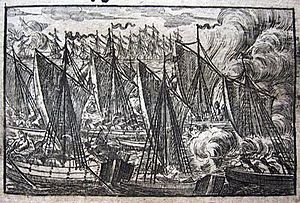Naval battles on Lake Ladoga
| date | June 15th jul. / June 26th 1702 greg. until August 27th jul. / 7th September 1702 greg. |
|---|---|
| place | in Lake Ladoga |
| output | Russian victories on June 26th and September 7th, 1702 |
| Parties to the conflict | |
|---|---|
| Commander | |
|
|
|
| Troop strength | |
|
on June 26th: 400 Russian soldiers in 18 boats; on September 7th: 30 boats |
3 brigantines, 3 galleys and 2 boats |
| losses | |
|
5 boats |
|
1st phase: Swedish dominance (1700–1709)
Riga I • Jungfernhof • Varja • Pühhajoggi • Narva • Pechora • Düna • Rauge • Erastfer • Hummelshof • Embach • Tartu • Narva II • Wesenberg I • Wesenberg II
Arkhangelsk • Lake Ladoga • Nöteborg • Nyenschanz • Neva • Systerbäck • Petersburg • Vyborg I • Porvoo • Neva II • Koporje II • Kolkanpää
Vilnius • Salads • Jacobstadt • Walled Courtyard • Mitau • Grodno I • Olkieniki • Nyaswisch • Klezk • Ljachavichy
Klissow • Pułtusk • Thorn • Lemberg • Warsaw • Posen • Punitz • Tillendorf • Rakowitz • Praga • Fraustadt • Kalisch
Grodno II • Golovchin • Moljatitschi • Rajowka • Lesnaja • Desna • Baturyn • Koniecpol • Weprik • Opischnja • Krasnokutsk • Sokolki • Poltava I • Poltava II
2nd phase: Sweden on the defensive (1710–1721)
Riga II • Vyborg II • Pernau • Kexholm • Reval • Hogland • Pälkäne • Storkyro • Nyslott • Hanko
Helsingborg • Køge Bay • Gulf of Bothnia • Frederikshald I • Dynekilen Fjord • Gothenburg I • Strömstad • Trondheim • Frederikshald II • Marstrand • Ösel • Gothenburg II • Södra Stäket • Grönham • Sundsvall
Elbing • Wismar I • Lübow • Stralsund I • Greifswalder Bodden I • Stade • Rügen • Gadebusch • Altona • Tönning II • Stettin • Fehmarn • Wismar II • Stralsund II • Jasmund • Peenemünde • Greifswalder Bodden II • Stresow
The sea battles on Lake Ladoga took place on June 15, July. / June 26th 1702 greg. and on August 27th jul. / 7th September 1702 greg. between two small sea flotillas of the newly established Russian Navy and the Swedish Navy during the Great Northern War on Lake Ladoga . As a result, hundreds of small Russian boats succeeded in forcing the Swedish flotilla to evacuate Lake Ladoga, thereby securing naval supremacy on Lake Ladoga for Russia and ensuring further land operations for the conquest of the Newaumland by Russia.
prehistory
The outbreak of war with Sweden in 1700 required immediate Russian reinforcements of the border areas with Sweden in north-western Russia . Lake Ladoga, which separated Russian and Swedish possessions, was of particular importance. The lake was a suitable gateway to the hostile territory.
Sweden owned a small flotilla consisting of brigantines and galleys that patrolled the lake to protect its western regions of Ingermanland and Karelia . They were equipped with a total of 55 cannons. All cannons came from discarded stocks of the fortresses of Nöteborg and Kexholm.
| Ship name | Number of cannons |
|---|---|
| Jioia | 12 |
| Astrid | 11 |
| Dusa | 12 |
| Thor | 16 |
| Laksen | 6th |
| Geddan | 6th |
| Aboriginal | - |
| Giron | - |
At the beginning of 1701, Peter I issued the order to manufacture a total of 600 small rowing boats, each equipped with a sail, in various shipyards on Russian-controlled tributaries of Lake Ladoga, in order to support Russian land operations from the seaside and ultimately an access to the Baltic Sea from Sweden for Russia to conquer. Despite their low combat strength, these small sea boats were supposed to attack the few larger Swedish ships like swarms and ultimately drive them away from Lake Ladoga.
course
On June 26th, 400 Russian soldiers in 18 small unarmed boats met a Swedish flotilla consisting of three brigantines, three galleys and two boats on the western shore of the lake. The Swedes were at a disadvantage, while the flotilla was anchored much of the crew was ashore when the Russian boats arrived. In the erupting fighting, the Swedish flagship, the 12-cannon Brigantine Gjöa was damaged and the Swedes were forced to retreat.
On September 7th, the same Swedish flotilla was attacked by thirty Russian boats near Kexholm , on the northwestern bank of Lake Ladoga. The situation of the beleaguered Swedish flotilla became so hopeless that the Swedish commander Nummers decided to evacuate the flotilla entirely from Lake Ladoga.
consequences
The evacuation of the Swedish flotilla up the Neva to Vyborg opened Lake Ladoga to unlimited Russian supplies, which enabled extensive Russian attack operations deep in Swedish Ingermanland and Newaumland. In autumn 1702 Nöteborg was conquered by Russian troops.
literature
- RC Anderson: Naval wars in the Baltic, London, 1910, p. 137
- Robert K. Massie: Peter the Great: His Life and World, New York, 1980, p. 350
- Edward J. Phillips: The Founding of Russia's Navy: Peter the Great and the Azov Fleet, 1688-1714, 1995
Individual evidence
- ↑ George Dobsen: St. Petersburg, 1910, p. 54

